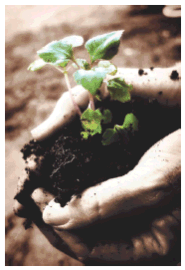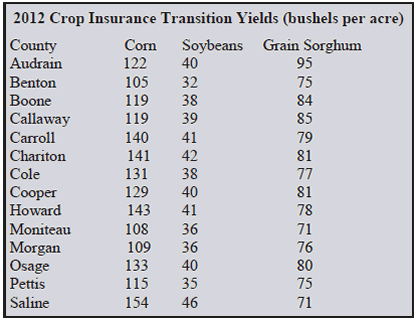

To send a message to an author, click on the author's name at the end of the article.
This Month in Ag Connection | Ag Connection - Other Issues Online
Routine application of gypsum has been shown to improve soil tilth and health. With the use of gypsum, the soil is more manageable and productive which translates to higher, more sustainable yields and greater profit. The use of gypsum is becoming a more common topic where soil conditions and fertility are being discussed at field days and some agricultural events.
Most, if not all producers, have heard of gypsum. Gypsum, or calcium sulfate, contains 22% to 24% calcium and 16% to 18% sulfur. Gypsum is not a new agricultural product; it was used as a fertilizer in Europe during the late 1800’s. Gypsum comes from mined sources or as a by-product of industrial processes.

The benefits of using gypsum are as follows. First, calcium and sulfur are important secondary nutrients and can help ameliorate subsoil acidity and aluminum toxicity. Second, gypsum can be used to reclaim soils high in sodium (Na) or magnesium (Mg) where the calcium displaces Na and Mg ions on soil particle exchange sites, allowing the two "salts" to leach deeper into the soil profile. Finally, improving the soil tilth is one of the well-known results of applying gypsum. The improvement in tilth is the result of the calcium flocculating or pulling together clay particles into larger natural clumps. This increase in clumping improves soil structure and porosity leading to better tilth. A soil with good tilth tends to have more active biology and better health. This means less surface crusting, fewer problems with seedling emergence, more water infiltration and less runoff, better gas exchange and root penetration. The improved soil structure should also result in the soil soaking up and holding water. Tight clay soils amended with gypsum more readily absorb water and move it down through the soil profile. Producers with heavy clay soils have noticed that tillage is easier after the use of gypsum.
Gypsum is more difficult to buy than dry fertilizer. Agricultural grade is the lowest grade and least expensive. It can come as a pulverized powder, similar to lime, or pelletized. Food grade gypsum is a synthetic source of calcium sulfate, which is a by-product that can come from several different industrial processes. Rate of application is dependent on the source of the gypsum. Gypsum is applied using similar methods as lime but may vary on the source being applied. Rates will also vary with the source of gypsum being used.
This Month in Ag Connection | Ag Connection - Other Issues Online
Wayne Bailey, University of Missouri Extension specialist in plant sciences, urges Missouri corn producers to keep an eye out for indications of corn rootworm infestation and damage, caused by continuous planting of Bt hybrid corn on cropland.
Most of the corn planted in the United States is Bt corn, and the Cry3Bb1 toxin is the major one deployed in corn against rootworm.
Research at Iowa State University shows evolving resistance in progeny of adult western corn rootworms collected from northwestern Iowa fields in which Bt hybrids that produce the Cry3Bb1 protein had been planted for several consecutive years. The pest has also been seen in Illinois fields.
Bt hybrids used for corn rootworm control are low- to moderate-dose events that leave survivors in every field. When enough heterozygotes survive and mate, a Bt-resistant population can increase rapidly.
There is no evidence of a problem in Missouri yet, but some producers are concerned because Illinois grain producers are seeing it in some counties. Less than 10 percent of the corn fields in Missouri are at risk. Those at risk include fields planted in corn for three or more continuous years, fields where CryBb1 protein has been used, and those where there is relatively high western corn rootworm pressure.
Corn producers should watch for evidence of rootworms in spring fields. They can slow growth of rootworm in fields by using soil insecticides in furrow.
Producers who use Cry3Bb1 more than three years should consider an alternate hybrid.
Crop rotation provides the best defense against rootworm, but there are pockets of farmland not in a rotation sequence. This land would include land generally dedicated to producing corn for livestock and ethanol, and geographic pockets where corn has been the only crop planted. In some regions, rootworm management options are limited because of resistance to Cry3Bb1.
Source: Wayne Bailey, State SpecialistMU and Jim JarmanAgronomy Specialist
This Month in Ag Connection | Ag Connection - Other Issues Online
Many hoop-house structures seem to literally be "popping up" in central Missouri that will grow and feed livestock. Why? Are they that much more efficient than open lot confinement facilities? Are they cost effective enough to justify their expense verses open lot confinement? A comprehensive study was done from 2007 to 2009, determining these questions.

Records of closeouts from 997 lots (i.e. pens or groups) fed in the Upper Midwest (primarily in Iowa, South Dakota, Nebraska and Minnesota) in deep bedded confinement buildings were compared to open lot confinement facilities. Deep bedded confinement buildings have been cropping up all over the Mid-West and Missouri is no exception to this. A 10-year review from Iowa State University of cattle closeouts (1,836 pens) observed that cattle fed in slatted confinements had reduced intake, ADG, and finish body weight verses feeding cattle in open lots with or without shelter. According to Iowa State, the cattle fed in slatted floor confinements consistently consumed less feed in these studies.
Deep bedded housing is a confinement option with reduced initial construction costs verses slatted-floor confinement barns according to the 2006 Beef Feedlot Systems Manual from the Iowa Beef Center. These systems also offer improved nutrient management and conservation, according to studies at Iowa State University. To date, no studies had been done on performance differences between deep bedded confined beef housing and traditional lots under field conditions in the Midwest. So how did the study go, when comparing the two systems?
This study shows cattle fed in bedded confinement buildings had greater average daily gain (ADG), gain to feed (G:F) and heavier finish weight than those cattle fed in open lots. The data also suggested cattle fed in bedded, confinement buildings may have improved efficiency by reducing metabolic requirements and improved cattle comfort. There was also greater economic return with the bedded confinement feedlot facilities.
The study also looked at two deep bedding pack systems during the summer and found the bedding pack can affect barn environment and animal behavior. Ammonia from the bedding pack increased with higher pack and temperatures; also, the cattle avoided lying on the deep bedding pack during the summer because of the heat coming out of those packs. It is suggested by the researchers to use a shallow bedding pack during the summer as it appeared to improve cattle comfort and possibly ammonia levels as well.
For producers in Missouri, this might be a viable way to feed cattle without the cost associated with a slatted floor confinement system and would actually increase cattle performance and provide a better nutrient management system over an open lot facility. For more information look at Iowa State’s 2006 "Beef Feedlot Systems Manual" Information about hoop houses can be found at: www.leopold.iastate.edu
Source: Wendy Rapp Livestock Specialist
This Month in Ag Connection | Ag Connection - Other Issues Online
Since a new farm bill has not passed, there are currently only a few changes concerning crop insurance. When there is a new farm bill additional changes will be expected.
Crop insurance continues to be a big management decision for farmers in Missouri. During 2012, more than 3 million acres of corn, 4 million acres of soybeans, and a half million acres of wheat were insured in Missouri. The amount of premiums paid by farmers totaled more than $124 million. Statistics show the most popular choice for corn and soybean is revenue protection insurance at the 70 to 80% level.
The 2012 drought caused low yields in many parts of the state. Farms with low yields may likely cause actual production history (APH) to decline. There are two things producers may do to help manage the decline.

First, a producer can request to have any yield in the yield history replaced by 60% of Transitional yield (T yield). T yields are estimated county yields. Producers with 2012 yields below 60% of T yield may request to have their actual yield replaced by 60% of the T yield. (See table with T yields.)
Example: If a farm in Audrain County where the T yield for corn is 122 bushels per acre for dryland corn has a yield below 73.2 bu. per acre (122 bu. T yield x 60%), that producer may request to have the farm actual yield replaced by 73.2 bushels per acre. This substitution will limit yield declines.
How much difference could it make? Using the same Audrain County farm with a 10-year yield history where the historic yields exactly equal the county averages in each year. The farm would have had a 2012 APH yield of 122 bushels per acre (bpa). If this farm has a yield below 73.2 in 2012, then the 73.2 could be used in the APH yield calculation, resulting in a 2013 APH yield of 117 bpa. This farm’s APH will decline by 5 bushels between 2012 and 2013. If the substitution was not used the decline would be larger than 5 bushels.
Trend-Adjusted Actual Production History (APH) Yield Option is the second management option to offset the impact of poor yields this past year. The trend-adjusted APH was available in several Missouri counties this past year and will be expanded in 2013 to all counties.
Many farmers are going to get audited this year because their claims will exceed the trigger. An audit does not mean USDA Risk Management Agency (RMA) or crop insurance companies expect fraud. The RMA rules specify that any indemnity over $100,000 be audited. Due to the number of automatically triggered audits this year, RMA raised the level to $200,000. One part of the audit which can be troublesome is the farmer must show records to justify what he/she has been claiming as APH for crop insurance purposes. If the farmer does not have good yield records for the last ten years, the audit could be troublesome.
Your crop insurance agent can be a helpful resource in preparing for audit. He/she can also be helpful answering questions about the changes for 2013.
Source: Mary Sobba, Ag Business Specialist
This Month in Ag Connection | Ag Connection - Other Issues Online
Giant cane or Arundo donax, is a tall, long lived perennial grass usually found growing in stream and river bottom soils or boggy areas in southern temperate to tropical areas; although, it is adapted to many different soil and fertility types. It is being studied for bio-energy uses along with giant miscanthus grass and the native switchgrass among others. Additional common names include Arundo, Colorado reed, Carrizo, giant reed, Spanish cane and wild cane or reed. It is often referred to as a reed since Arundo donax is the primary source of reeds for woodwind musical instruments.

Giant cane is an exotic plant generally growing to 20 feet but under ideal conditions it can reach 33 feet tall. As with other canes it has hollow stems around 1 inch in diameter. The grey-green leaves are 12 to 24 inches long and around 1 to 2 inches wide. Overall, it resembles a larger version of common reed or a bamboo. In addition, it is among the fastest growing plants in the world at 4 inches a day. Annual biomass estimates average 25 tons per acre once established.
When giant cane flowers, it looks like several other tall, warm season grasses with a feathery, plumed seed head but it contains mostly infertile seeds. It readily reproduces by rhizomes. Also, giant cane does not provide any food or nesting for wildlife. Its growth crowds-out native plants. These characteristics have made it unwelcomed in many states where it is considered an invasive and noxious weed. The only thing making it less of a potential problem in Missouri is being unable to stand many of our winters making it an annual here.
It is not likely to become an important crop here because the annual planting of rhizomes will be a lot of trouble, planting tillage will be erosive and the first year’s growth probably would not create a sufficient amount of biomass.
Source: Jim Jarman, Agronomy Specialist
This Month in Ag Connection | Ag Connection - Other Issues Online
Publishing Information
Ag Connection is published monthly for Northeast and Central areas of Missouri producers and is supported by the University of Missouri Extension, the Missouri Agricultural Experiment Station, and the MU College of Agriculture, Food and Natural Resources. Managing Editor: Mary Sobba.